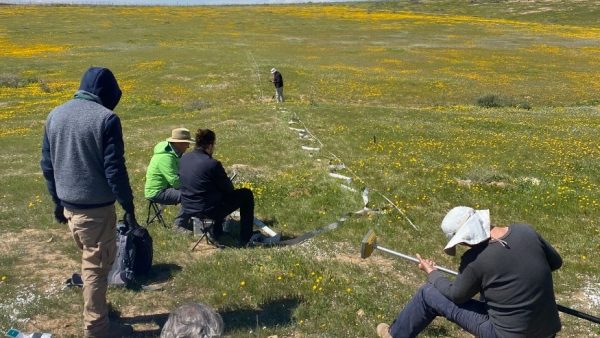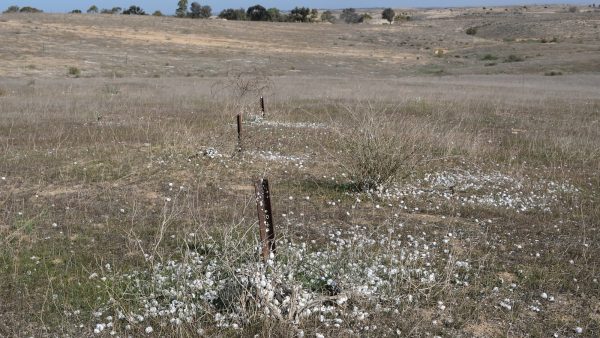




LTER site /LTSER platform established at 1997
Site manager: Shayli Dor-Haim
Contact: Shayli Dor-Haim
Operating Organization KKL
General Site Description:
Designation: Ecosystem research and management under livestock grazing and climate change. Climate: Mean annual precipitation 150-200mm (Fig. 2) between November and April; mean maximum summer temperature 34° C, mean minimum winter temperature 6° C. (Data available for 15-min interval meteorological measurements and daily summaries for rainfall, air and soil humidity and temperature, wind velocity and direction, from 1997 to the present.) Principal biomes: Semiarid shrub land (shrub-grass steppe), rocky and loess watersheds, ephemeral streams. Vegetation is dominated by patch-forming dwarf shrubs (Noaea mucronata, Atractylis serratuloides and Thymelea hirsuta) with species-rich annual winter vegetation in the inter shrub (dominated by Stipa capensis and other grasses) and shrub patch understory (dominated by Anagallis arvensis and other forbs). Management: Livestock grazing excluded in central watershed (20 ha) since 1987; restricted/controlled grazing by Bedouin sheep herds in surroundings; in the outer parts of the area native and exotic trees were planted in 1985-87 in contour dykes (‘shikhim’). Research: 1. Long-term experiments (up to 20 years) for monitoring changes in abundance, diversity, species composition and distribution, and development of biological soil crusts (BSC), perennial plants (dwarf shrubs) and winter annuals in relation to rainfall, soil disturbance, patch distribution, and livestock grazing. 2. Short-term experiments and surveys (1 to 5 years) for testing hypotheses about the detailed processes, mechanisms and interactions involved in the development, dynamics and stability of shrub- and BSC-dominated patches, their landscape mosaic patterns and their feed-back relationships with flows of materials through the landscape. 3. Network-related research including regional comparisons of herbaceous plant productivity in open rangeland along the Israeli North-South rainfall gradient, and global comparison of woody plant diversity effects on ecosystem functionality of most dryland regions of the world.
https://deims.org/869ec32d-7530-4975-a9de-604374eaece6
Purpose of Site:
Ecosystem research and management under livestock grazing and climate change; Small to large scale relationships between landscape, vegetation, hydrology, nutrient dynamics; Sustainable livestock grazing, land degradation, recovery, restoration; Temporal vegetation responses to inter-annual variation in rainfall; Patch and pattern formation by dwarf shrubs, annual herbs and biological soil crusts; Biological soil crust development, disturbance, function and species composition; Regional and global comparisons of dryland ecosystems.
History of site:
Park Shaked is an active research and education area, that existed from 1993.
The park was established as a long term national and international project for studying desertification and how to combat it. The area is divided to three study: 1. Scientific area – An area that is devoted to study the ecological processes related to natural and human management of ecosystems. This area is of international importance. The models and the management program in this area enable to convert degraded areas into fertile land that provide humans with many ecosystem services; 2. KKL legacy – to study and transfer the knowledge of KKL legacy of combating desertification mainly by water harvesting methods ;3. Educational area- in which we transfer the ideas about ecological restoration and sustainable land-use to the Israeli and to the international community.
A very important component of Park Shaked activities are the study of climate change, its impact on natural resources and how to use scientific based ideas to cope with the undesired consequences of climate change.
Park Shaked is unique on an international level by having a watershed that collapse driven by a severe drought. The study of this watershed is important to the scientific and the management community because it provide insights how to cope with climate change that is one of the most important challenges to human being in the 21th century.
Monitored parameters: above ground biomass, plant species richness, meteorological parameters, mesofauna, plant-litter decomposition
Publications:
- Argaman, E., Barth, R., Moshe, Y., & Ben-Hur, M. (2020). Long-term effects of climatic and hydrological variation on natural vegetation production and characteristics in a semiarid watershed: The northern Negev, Israel. Science of The Total Environment, 747, 141146.
- Boeken, B. R. (2018). Competition for microsites during recruitment in semiarid annual plant communities. Ecology, 99(12), 2801-2814.
- Boeken, B., Shachak, M., Zaady, E., & Brand, S. (2010, May). Shrubs as landscape modulators in semiarid shrubland-long-term studies in Park Shaked LTER, Israel. In EGU General Assembly Conference Abstracts (p. 15561).
- De Falco, N., Tal-Berger, R., Hjazin, A., Yizhaq, H., Stavi, I., & Rachmilevitch, S. (2021). Geodiversity impacts plant community structure in a semi-arid region. Scientific reports, 11(1), 1-11.
- Hoffman, O., de Falco, N., Yizhaq, H., & Boeken, B. (2016). Annual plant diversity decreases across scales following widespread ecosystem engineer shrub mortality. Journal of Vegetation Science, 27(3), 578-586.
- Hoffman, O., Yizhaq, H., & Boeken, B. (2017). Shifts in landscape ecohydrological structural–functional relationship driven by experimental manipulations and ecological interactions. Ecohydrology, 10(3), e1806.
- Paz-Kagan, T., Panov, N., Shachak, M., Zaady, E., & Karnieli, A. (2014). Structural changes of desertified and managed shrubland landscapes in response to drought: Spectral, spatial and temporal analyses. Remote Sensing, 6(9), 8134-8164.
- Shachak, M., & Pickett, S. T. A. (1997). Linking ecological understanding and application: patchiness in a dryland system. In The ecological basis of conservation (pp. 108-119). Springer, Boston, MA.
- Shachak, M., Pickett, S. T., Boeken, B., & Zaady, E. (1999). Managing patchiness, ecological flows, productivity, and diversity in drylands: concepts and applications in the Negev Desert. Arid lands management: Toward ecological sustainability, 254-263.
- Shachak, M., Sachs, M., & Moshe, I. (1998). Ecosystem management of desertified shrublands in Israel. Ecosystems, 1(5), 475-483.
- Stavi, I., Rachmilevitch, S., & Yizhaq, H. (2019). Geodiversity effects on soil quality and geo-ecosystem functioning in drylands. Catena, 176, 372-380.
- Yizhaq, H., Stavi, I., Shachak, M., & Bel, G. (2017). Geodiversity increases ecosystem durability to prolonged droughts. Ecological Complexity, 31, 96-103.
- Zaady, E., Arbel, S., Barkai, D., & Sarig, S. (2013). Long-term impact of agricultural practices on biological soil crusts and their hydrological processes in a semiarid landscape. Journal of Arid Environments, 90, 5-11.
- Zaady, E., Stavi, I., & Yizhaq, H. (2021). Hillslope geodiversity effects on properties and composition of biological soil crusts in drylands. European Journal of Soil Science, 72(5), 2308-2315.
- Zaady, E., Yonatan, R., Shachak, M., & Perevolotsky, A. (2001). The effects of grazing on abiotic and biotic parameters in a semiarid ecosystem: A case study from the Northern Negev Desert, Israel. Arid Land Research and Management, 15(3), 245-261.





